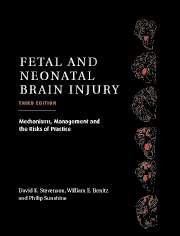Book contents
- Frontmatter
- Contents
- List of contributors
- Foreword
- Preface
- Part I Epidemiology, Pathophysiology, and Pathogenesis of Fetal and Neonatal Brain Injury
- Part II Pregnancy, Labor, and Delivery Complications Causing Brain Injury
- Part III Diagnosis of the Infant with Asphyxia
- Part IV Specific Conditions Associated with Fetal and Neonatal Brain Injury
- Part V Management of the Depressed or Neurologically Dysfunctional Neonate
- Part VI Assessing the Outcome of the Asphyxiated Infant
- 40 Assessment of preterm infants' neurobehavioral functioning: reliability, validity, normative data, and prediction to age two
- 41 Long-term follow-up of term infants with perinatal asphyxia
- 42 Appropriateness of intensive care application
- 43 Medicolegal issues in perinatal brain injury
- Index
- Plate section
42 - Appropriateness of intensive care application
from Part VI - Assessing the Outcome of the Asphyxiated Infant
Published online by Cambridge University Press: 10 November 2010
- Frontmatter
- Contents
- List of contributors
- Foreword
- Preface
- Part I Epidemiology, Pathophysiology, and Pathogenesis of Fetal and Neonatal Brain Injury
- Part II Pregnancy, Labor, and Delivery Complications Causing Brain Injury
- Part III Diagnosis of the Infant with Asphyxia
- Part IV Specific Conditions Associated with Fetal and Neonatal Brain Injury
- Part V Management of the Depressed or Neurologically Dysfunctional Neonate
- Part VI Assessing the Outcome of the Asphyxiated Infant
- 40 Assessment of preterm infants' neurobehavioral functioning: reliability, validity, normative data, and prediction to age two
- 41 Long-term follow-up of term infants with perinatal asphyxia
- 42 Appropriateness of intensive care application
- 43 Medicolegal issues in perinatal brain injury
- Index
- Plate section
Summary
The real question, it seems to me, is When may the application of intensive care be said to be inappropriate? rather than When is it appropriate? If it is not possible to specify circumstances in which or conditions for which intensive care is inappropriate, it is meaningless to speak of an appropriate application of the technology of the modern intensive care nursery. Unless saying no to aggressive interventions at times and for good reason is a genuine option, saying yes is emptied of all significance.
But this raises a second question: Who is to decide that the application of intensive care is inappropriate? Is this for the experts to determine – perinatologists, nurses, social workers, and other members of the perinatal team – or is it up to the parents of the neonate, the courts, or society at large?
Two questions then confront us in this chapter: What is inappropriate neonatal intensive care, and who decides that it is inappropriate? These questions seem straightforward enough, but they are fraught with difficulty, conceptual as well as emotional, and, depending on where one happens to live, practice, have children, and care for them, the answers to them will be quite different.
- Type
- Chapter
- Information
- Fetal and Neonatal Brain InjuryMechanisms, Management and the Risks of Practice, pp. 859 - 872Publisher: Cambridge University PressPrint publication year: 2003



